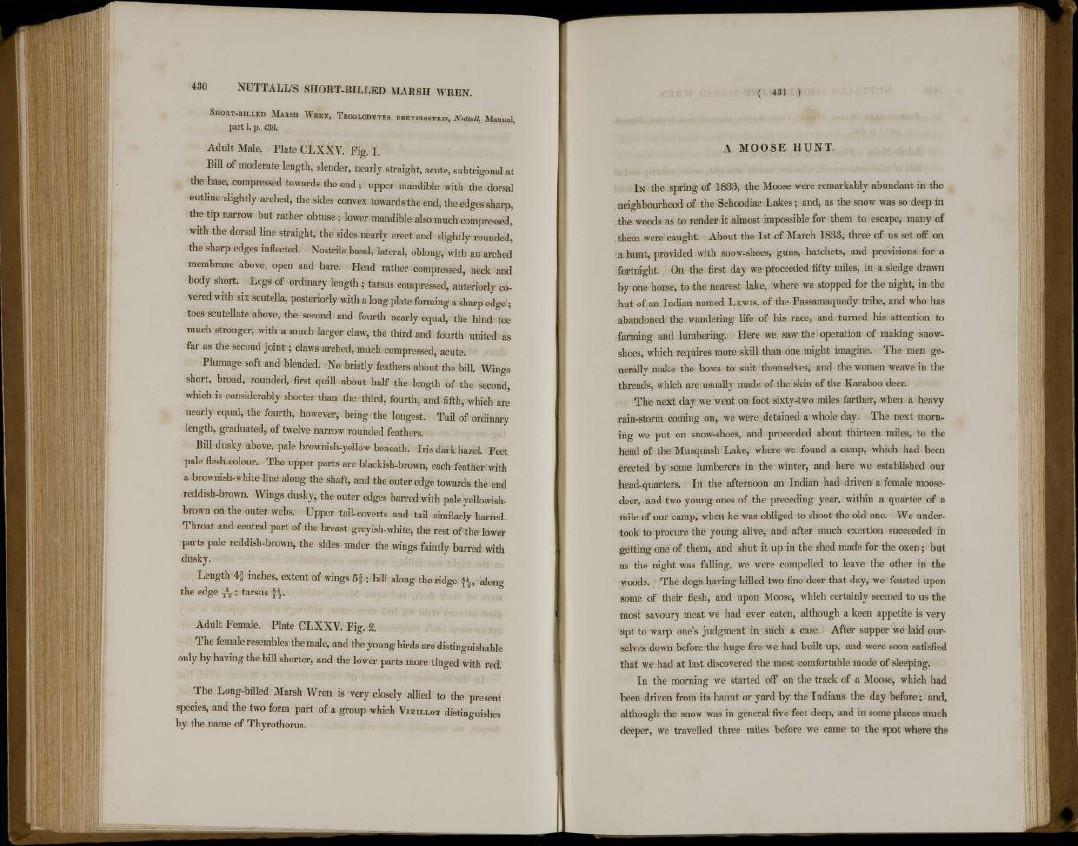
430 NUTTALL'S SHORT-BILLED MARSH WREN.
SHORT-BILLED MARSH WREX, TROGLODYTES BREVIROSTRIS, Nuttall, Manual,
part i. p. 436.
Adult Male. Plate CLXXV. Fig. 1.
Bill of moderate length, slender, nearly straight, acute, subtrigonal at
the base, compressed towards the end ; upper mandible with the dorsal
outline slightly arched, the sides convex towards the end, the edges sharp,
the tip narrow but rather obtuse ; lower mandible also much compressed,
with the dorsal line straight, the sides nearly erect and slightly rounded,
the sharp edges inflected. Nostrils basal, lateral, oblong, with an arched
membrane above, open and bare. Head rather compressed, neck and
body short. Legs of ordinary length ; tarsus compressed, anteriorly covered
with six scutella. posteriorly with a long plate forming a sharp edge ;
toes scutellate above, the second and fourth nearly equal, the hind toe
much stronger, with a much larger claw, the third and fourth united as
far as the second joint ; claws arched, much compressed, acute.
Plumage soft and blended. No bristly feathers about the bill. Wings
short, broad, rounded, first quill about half the length of the second,
which is considerably shorter than the third, fourth, and fifth, which are
nearly equal, the fourth, however, being the longest. Tail of ordinary
length, graduated, of twelve narrow rounded feathers.
Bill dusky above, pale brownish-yellow beneath. Iris dark hazel. Feet
pale flesh-colour. The upper parts are blackish-brown, each feather with
a brownish-white line along the shaft, and the outer edge towards the end
reddish-brown. Wings dusky, the outer edges barred with pale yellowishbrown
on the outer webs. Upper tail-coverts and tail similarly barred.
Throat and central part of the breast greyish-white, the rest of the lower
parts pale reddish-brown, the sides under the wings faintly barred with
dusky.
Length 4 | inches, extent of wings 5 | ; bill along the ridge along
the edge ^% ; tarsus
Adult Female. Plate CLXXV. Fig. 2.
The female resembles the male, and the young birds are distinguishable
only by having the bill shorter, and the lower parts more tinged with red.
The Long-billed Marsh Wren is very closely allied to the present
species, and the two form part of a group which VIEILLOT distinguishes
by the name of Thyrothorus.
( 431 )
A MOOSE HUNT.
I N the spring of 1833, the Moose were remarkably abundant in the
neighbourhood of the Schoodiac Lakes; and, as the snow was so deep in
the woods as to render it almost impossible for them to escape, many of
them were caught. About the 1st of March 1833, three of us set off on
a hunt, provided with snow-shoes, guns, hatchets, and provisions for a
fortnight. On the first day we proceeded fifty miles, in a sledge drawn
by one horse, to the nearest lake, where we stopped for the night, in the
hut of an Indian named LEWIS, of the Passamaquody tribe, and who has
abandoned the wandering life of his race, and turned his attention to
farming and lumbering. Here we saw the operation of making snowshoes,
which requires more skill than one might imagine. The men generally
make the bows to suit themselves, and the women weave in the
threads, which are usually made of the skin of the Karaboo deer.
The next day we went on foot sixty-two miles farther, when a heavy
rain-storm coming on, we were detained a whole day. The next morning
we put on snow-shoes, and proceeded about thirteen miles, to the
head of the Musquash Lake, where we found a camp, which had been
erected by some lumberers in the winter, and here we established our
head-quarters. In the afternoon an Indian had driven a female moosedeer,
and two young ones of the preceding year, within a quarter of a
mile of our camp, when he was obliged to shoot the old one. We undertook
to procure the young alive, and after much exertion succeeded in
getting one of them, and shut it up in the shed made for the oxen; but
as the night was falling, we were compelled to leave the other in the
woods. The dogs having killed two fine deer that day, we feasted upon
some of their flesh, and upon Moose, which certainly seemed to us the
most savoury meat we had ever eaten, although a keen appetite is very
apt to warp one's judgment in such a case. After supper we laid ourselves
down before the huge fire we had built up, and were soon satisfied
that we had at last discovered the most comfortable mode of sleeping.
In the morning we started off on the track of a Moose, which had
been driven from its haunt or yard by the Indians the day before; and,
although the snow was in general five feet deep, and in some places much
deeper, we travelled three miles before we came to the spot where the